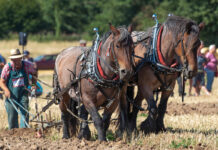
So many horses, so little time. Keeping multiple horses fit and trained can be a big challenge when you also have the demands of a full-time job or home and family responsibilities.
Get Clarity
Before diving into creating a workable schedule, clarify your goals and priorities. What are you aiming for? It could be any of the following:
◆ High-level competition in your chosen discipline or breed association.
◆ Local/regional competition for fun.
◆ Trail riding.
◆ Taking overnight pack trips several times per year.
◆ Riding your horses for pleasure, primarily at home.
◆ Keeping an older horse going with gentle exercise.
Once you’ve set your goals, it’s easier to focus on what it will take to accomplish your vision.
Obviously, campaigning several horses to qualify for national awards takes a different approach than keeping your horses fit and healthy for less intense activities.
In fact, if you have only an hour or two a day to work your horses and your goal is showing at the national level or competing in endurance rides, you may not be able to do it without help or having at least one horse in professional training.
However, the ideas here can apply to keeping your horses fit and trained no matter your end goal.
Since big gains come from consistency over time, you can do this even when you’re one rider with multiple horses. Ready to ride? Let’s go.
Trading Off
The name of the game comes down to trading off. While you can’t literally ride two horses at once (unless you’re a circus rider), you can develop a schedule for each horse that includes training, exercise and downtime each week in creative ways.
Using the ideas we cover below, see sample schedule below for Charlie, Teddy and Chance.
Pal Power
Seek out a horse friend, barn buddy, or a horseless rider with similar riding skills who has time to ride a few times a week. They can ride at the same time you do, or ride at a different time of the day. This is even better, as more of your horses can be ridden on the same day.
Time Hop
Try to get to the barn an hour earlier a couple days a week. With focus, you can work with three horses in two and a half hours.
Allow 15 minutes for tacking up and 30 minutes for training.
If your schedule allows, plan to spend more time working with your horses on your days off. In our sample schedule (see below), we’re assuming that’s Saturday and Sunday.
Pony Up
Teach your horses to pony, both as the ridden horse and the one being led.
This doubles the horses you can work at the same time.
While ponying may not be an intense fitness workout or allow technique practice, the paired walking and trotting can provide a little exercise and a relaxing no-agenda ride.
Training Days
Once your horses know their jobs—whether it’s dressage, jumping, barrel racing, or reining—they don’t need to be drilled every day. In fact, heavy daily training can be a recipe for burnout, sourness, soundness issues and injury.
Instead, train with focus and intention a few days a week, and use the other days for fitness maintenance.
Longeing
Done well, longeing can be a complete training session, incorporating cardio, responsiveness and self-carriage in a short amount of time. Instead of using a round pen for mindless circling, learn to use subtle voice, body position or longe whip signals for walk, trot, canter and halt.
Groundwork or Bodywork
Groundwork or bodywork that’s based on physiology, non-repetitive movement, and restoring body balance can also help your horses develop better carriage, avoid injury and relax their muscles. Tellington-Jones T-Touch, Equine Touch, Connected Riding and Masterson Method are a few to explore.
Rest and Turnout
Especially if your horses live in stalls or paddocks, turnout becomes an essential part of your training schedule. Like us, our horses need time off.
Meandering around in a pasture or large area is good for the body and the soul.
Try trading with a barn buddy to split turnout times on the days you can’t work all three horses. If your horses live in a pasture, give them one full day off a week to rest. And if you can schedule your horses’ rest day on the same day, you get a well-deserved day off as well.
Quality Over Quantity
Since you don’t have countless hours every day to work with your horses, focus on the quality of each ride or session. You can accomplish a lot in 20 or 30 minutes when you begin with clarity and a plan for the day. Quality and clear intention can bring bigger results than sheer quantity.
Go with the Flow
That said, remember that horses don’t wear watches, and they have good days and not-so-good days just like we do. Go with the flow and respond to what your horses need that day.
While you want to stick to your weekly training schedule as much as possible, switching out activities now and then won’t cause harm over the long run.
Curve Balls
Life will throw us curve balls. Mandatory overtime at work, sick family members, injury, weeks of rain or snow or heat—you know how it goes. The best we can do is work with what life presents and stay focused and centered through it all.
Having It All
With a little planning and developing a schedule, you can keep your horses fit, trained and happy. Enjoy the journey!
This article on keeping horses fit originally appeared in the August 2019 issue of Horse Illustrated magazine. Click here to subscribe!






